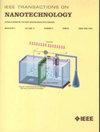Broadband Graphene/TiO2 Optical Modulator Based on Hybrid Plasmonic Waveguide for Ultrafast Switching and Low-Voltage State
IF 2.1
4区 工程技术
Q3 ENGINEERING, ELECTRICAL & ELECTRONIC
引用次数: 0
Abstract
This work presents a novel contribution to graphene/TiO 2 electro-optical modulators based on silicon-on-silica waveguide with a hybrid plasmonic waveguide to achieve ultrafast switching and low-voltage states. Waveguide structure consists of a rectangular silicon core covered by a high relative permittivity TiO 2 dielectric layer with two layers of graphene, air-clad, and silica lower cladding. Effective refractive indices can be tailored to support the propagation of the transverse magnetic mode with a suitable design related to an electro-absorption modulator for simulation results. Modulation depth and bandwidth were enhanced by the waveguide width and dielectric thickness, respectively. Maximum and minimum absorption depths at the driving voltage states can determine modulators. The simulation produced the highest efficient modulator with high speed at 3 dB bandwidth of 93.7 GHz using a low energy consumption of 210.6 fJ/bit, a small footprint (24 μm 2 ), and a broad operating spectrum range from 1310 to 1550 nm. This is because the physical process acts according to the modulator at the Fermi energy of graphene and the structure of the waveguide. These modulators can have practical applications due to their distinctive advantages, including a small device footprint, low voltage operation, ultrafast modulation switching across a broad wavelength range, and low-energy operation.基于混合质子波导的宽带石墨烯/二氧化钛光调制器,可实现超快切换和低电压状态
这项研究为石墨烯/二氧化钛电光调制器做出了新的贡献,该调制器基于硅基二氧化硅波导和混合等离子体波导,可实现超快开关和低电压状态。波导结构包括一个矩形硅芯,上面覆盖着高相对介电系数的二氧化钛介电层,以及两层石墨烯、空气包层和二氧化硅下包层。通过与电吸收调制器相关的适当设计,可以定制有效折射率,以支持横向磁模式的传播,从而获得模拟结果。波导宽度和介质厚度分别增强了调制深度和带宽。驱动电压状态下的最大和最小吸收深度可以确定调制器。仿真结果表明,调制器的能耗低(210.6 fJ/bit),占地面积小(24 μm2),工作光谱范围宽(1310 至 1550 nm),在 93.7 GHz 的 3 dB 带宽下速度最快。这是因为物理过程是根据调制器在石墨烯费米能和波导结构上的作用来实现的。这些调制器具有独特的优势,包括器件占地面积小、低电压工作、在宽波长范围内超高速调制切换以及低能耗工作,因此可用于实际应用。
本文章由计算机程序翻译,如有差异,请以英文原文为准。
求助全文
约1分钟内获得全文
求助全文
来源期刊

IEEE Transactions on Nanotechnology
工程技术-材料科学:综合
CiteScore
4.80
自引率
8.30%
发文量
74
审稿时长
8.3 months
期刊介绍:
The IEEE Transactions on Nanotechnology is devoted to the publication of manuscripts of archival value in the general area of nanotechnology, which is rapidly emerging as one of the fastest growing and most promising new technological developments for the next generation and beyond.
 求助内容:
求助内容: 应助结果提醒方式:
应助结果提醒方式:


